Abstract
To investigate the effects of calcium disodium ethylenediamine tetra-acetate (CaEDTA) on the urinary excretion, erythrocyte, and plasma concentrations and exposure indicators of seven heavy metals, CaEDTA was administered by intravenous infusion to 20 workers exposed to lead, zinc, and copper. The workers' blood lead concentrations ranged from 22 to 59 micrograms/dl (mean 38 micrograms/dl (1.8 mumol/l]. The 24 hour urinary excretion of metals after CaEDTA administration (mobilisation yield) was on average 13 times the background excretion for lead, 11 times for zinc, 3.8 times for manganese, 3.4 times for cadmium, 1.3 times for copper, and 1.1 times for chromium; no significant increase was found for mercury. The mobilisation yield of lead (MPb) was significantly correlated with whole blood and erythrocyte concentrations and the urinary excretion of lead but not with its plasma concentration; similarly, the mobilisation yield of cadmium was significantly correlated with its erythrocyte concentration. In addition, MPb was significantly correlated with intra-erythrocytic enzyme delta-aminolaevulinic acid dehydratase activity and urinary coproporphyrin excretion. The relation between the mobilisation yield of heavy metals and their body burden (and toxic signs) is discussed in the light of these findings.
Full text
PDF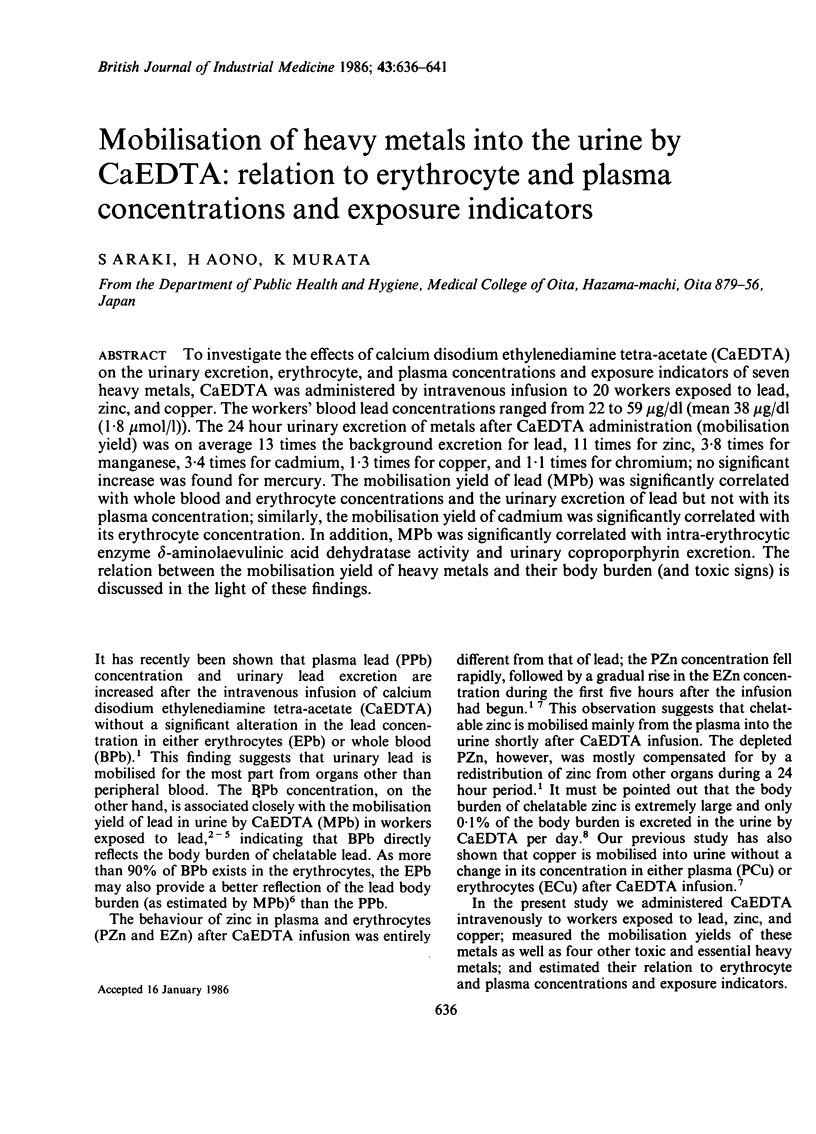
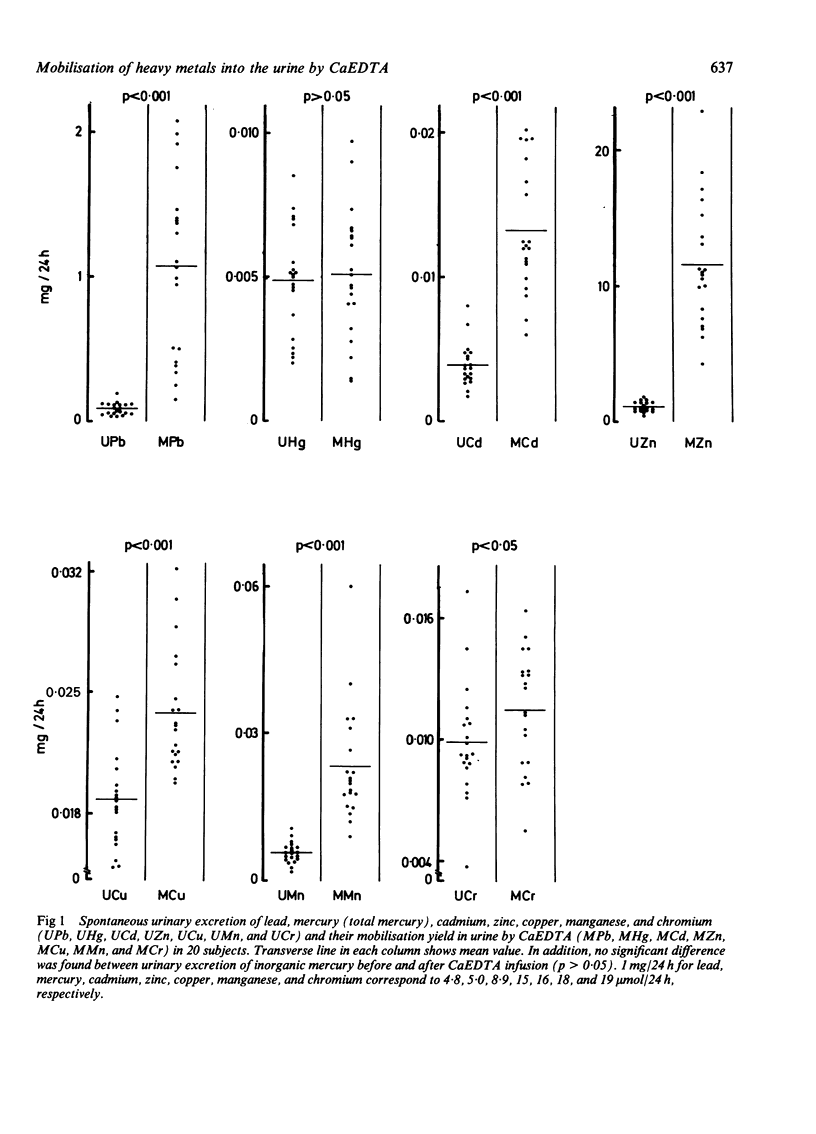
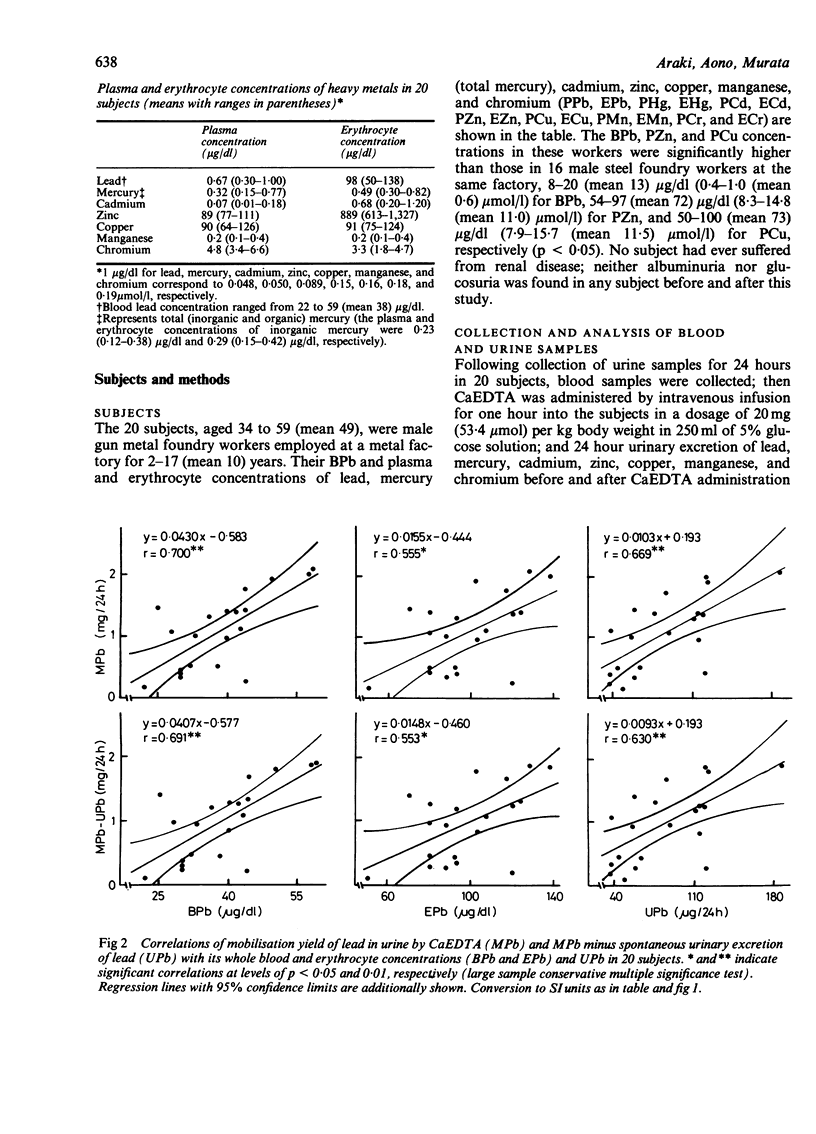
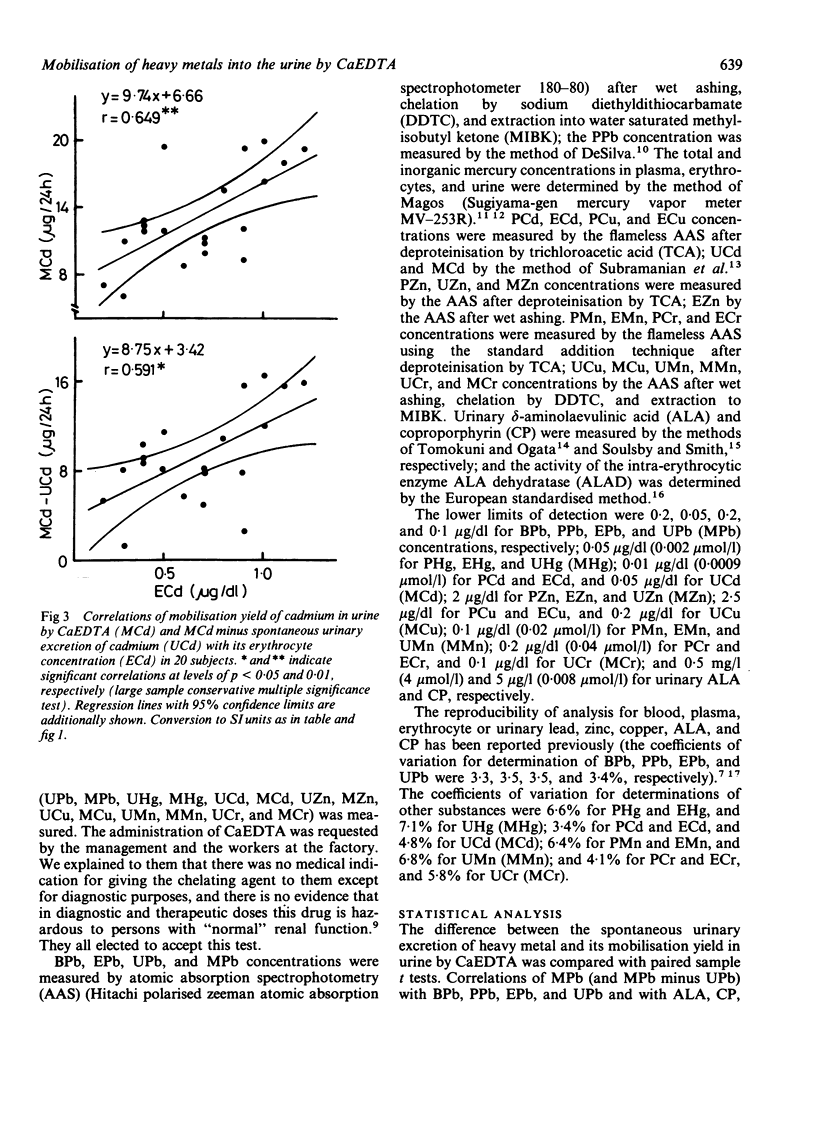
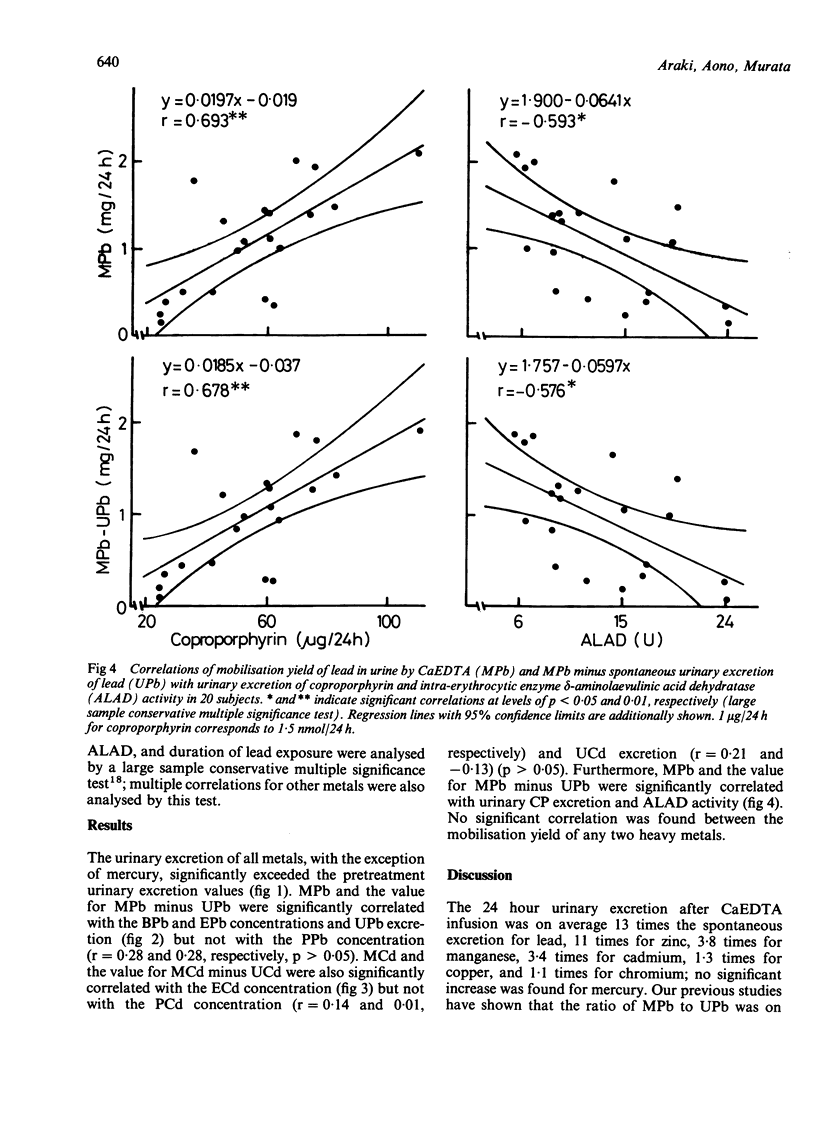
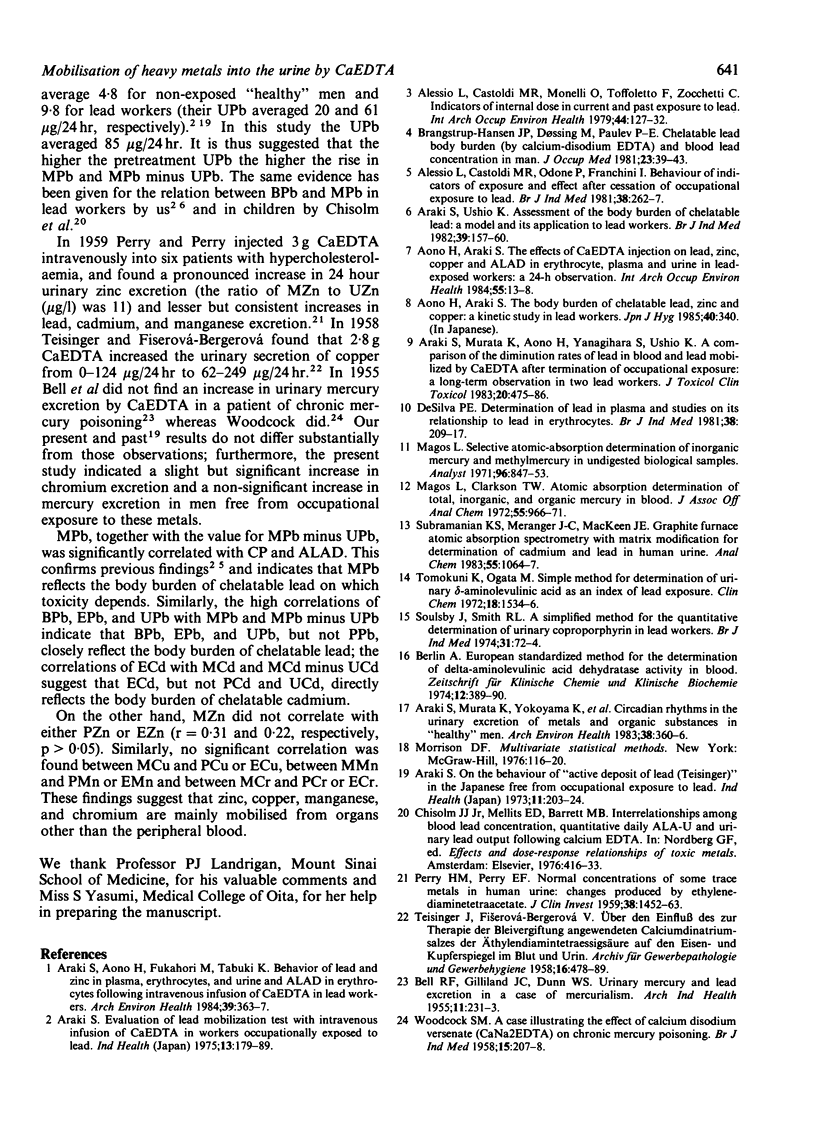
Selected References
These references are in PubMed. This may not be the complete list of references from this article.
- Alessio L., Castoldi M. R., Monelli O., Toffoletto F., Zocchetti C. Indicators of internal dose in current and past exposure to lead. Int Arch Occup Environ Health. 1979 Sep;44(2):127–132. doi: 10.1007/BF00386746. [DOI] [PubMed] [Google Scholar]
- Aono H., Araki S. The effects of CaEDTA injection on lead, zinc, copper and ALAD in erythrocyte, plasma and urine in lead-exposed workers: a 24-h observation. Int Arch Occup Environ Health. 1984;55(1):13–18. doi: 10.1007/BF00378063. [DOI] [PubMed] [Google Scholar]
- Araki S., Aono H., Fukahori M., Tabuki K. Behavior of lead and zinc in plasma, erythrocytes, and urine and ALAD in erythrocytes following intravenous infusion of CaEDTA in lead workers. Arch Environ Health. 1984 Sep-Oct;39(5):363–367. doi: 10.1080/00039896.1984.10545865. [DOI] [PubMed] [Google Scholar]
- Araki S., Murata K., Aono H., Yanagihara S., Ushio K. A comparison of the diminution rates of lead in blood and lead mobilized by CaEDTA after termination of occupational exposure: a long-term observation in two lead workers. J Toxicol Clin Toxicol. 1983 Jul;20(5):475–486. doi: 10.3109/15563658308990613. [DOI] [PubMed] [Google Scholar]
- Araki S., Murata K., Yokoyama K., Yanagihara S., Niinuma Y., Yamamoto R., Ishihara N. Circadian rhythms in the urinary excretion of metals and organic substances in "healthy" men. Arch Environ Health. 1983 Nov-Dec;38(6):360–366. doi: 10.1080/00039896.1983.10545821. [DOI] [PubMed] [Google Scholar]
- BELL R. F., GILLILAND J. C., DUNN W. S. Urinary mercury and lead excretion in a case of mercurialism; differential excretion after administration of edathamil calcium and dimercaprol. AMA Arch Ind Health. 1955 Mar;11(3):231–233. [PubMed] [Google Scholar]
- Berlin A., Schaller K. H. European standardized method for the determination of delta-aminolevulinic acid dehydratase activity in blood. Z Klin Chem Klin Biochem. 1974 Aug;12(8):389–390. [PubMed] [Google Scholar]
- Hansen J. P., Døssing M., Paulev P. E. Chelatable lead body burden (by calcium-disodium EDTA) and blood lead concentration in man. J Occup Med. 1981 Jan;23(1):39–43. doi: 10.1097/00043764-198101000-00017. [DOI] [PubMed] [Google Scholar]
- Magos L., Clarkson T. W. Atomic absorption determination of total, inorganic, and organic mercury in blood. J Assoc Off Anal Chem. 1972 Sep;55(5):966–971. [PubMed] [Google Scholar]
- Magos L. Selective atomic-absorption determination of inorganic mercury and methylmercury in undigested biological samples. Analyst. 1971 Dec;96(149):847–853. doi: 10.1039/an9719600847. [DOI] [PubMed] [Google Scholar]
- PERRY H. M., Jr, PERRY E. F. Normal concentrations of some trace metals in human urine: changes produced by ethylenediaminetetraacetate. J Clin Invest. 1959 Aug;38(8):1452–1463. doi: 10.1172/JCI103922. [DOI] [PMC free article] [PubMed] [Google Scholar]
- Soulsby J., Smith R. L. A simplified method for the quantitative determination of urinary coproporphyrin in lead workers. Br J Ind Med. 1974 Jan;31(1):72–74. doi: 10.1136/oem.31.1.72. [DOI] [PMC free article] [PubMed] [Google Scholar]
- Subramanian K. S., Meranger J. C., MacKeen J. E. Graphite furnace atomic absorption spectrometry with matrix modification for determination of cadmium and lead in human urine. Anal Chem. 1983 Jun;55(7):1064–1067. doi: 10.1021/ac00258a020. [DOI] [PubMed] [Google Scholar]
- TEISINGER J., FISEROVA-BERGEROVA V. Uber den Einfluss des zur Therapie der Bleivergiftung angewendeten Calciumdinatriumsalzes der Athylendiamintetraessigsäure auf den Eisen- und Kupferspiegel im Blut und Urin. Arch Gewerbepathol Gewerbehyg. 1958;16(4):478–489. [PubMed] [Google Scholar]
- Tomokuni K., Ogata M. Simple method for determination of urinary -aminolevulinic acid as an index of lead exposure. Clin Chem. 1972 Dec;18(12):1534–1538. [PubMed] [Google Scholar]
- WOODCOCK S. M. A case illustrating the effect of calcium disodium versenate (CaNa2E.D.T.A.) on chronic mercury poisoning. Br J Ind Med. 1958 Jul;15(3):207–208. doi: 10.1136/oem.15.3.207. [DOI] [PMC free article] [PubMed] [Google Scholar]
- deSilva P. E. Determination of lead in plasma and studies on its relationship to lead in erythrocytes. Br J Ind Med. 1981 Aug;38(3):209–217. doi: 10.1136/oem.38.3.209. [DOI] [PMC free article] [PubMed] [Google Scholar]


